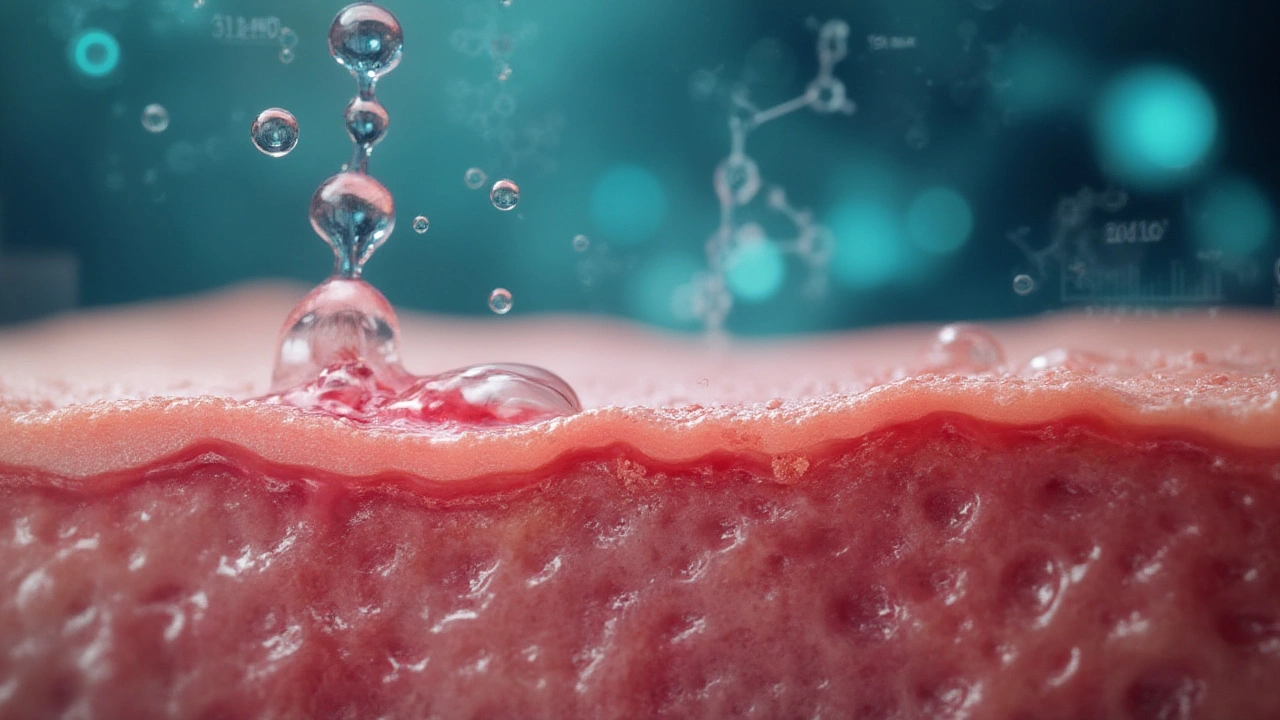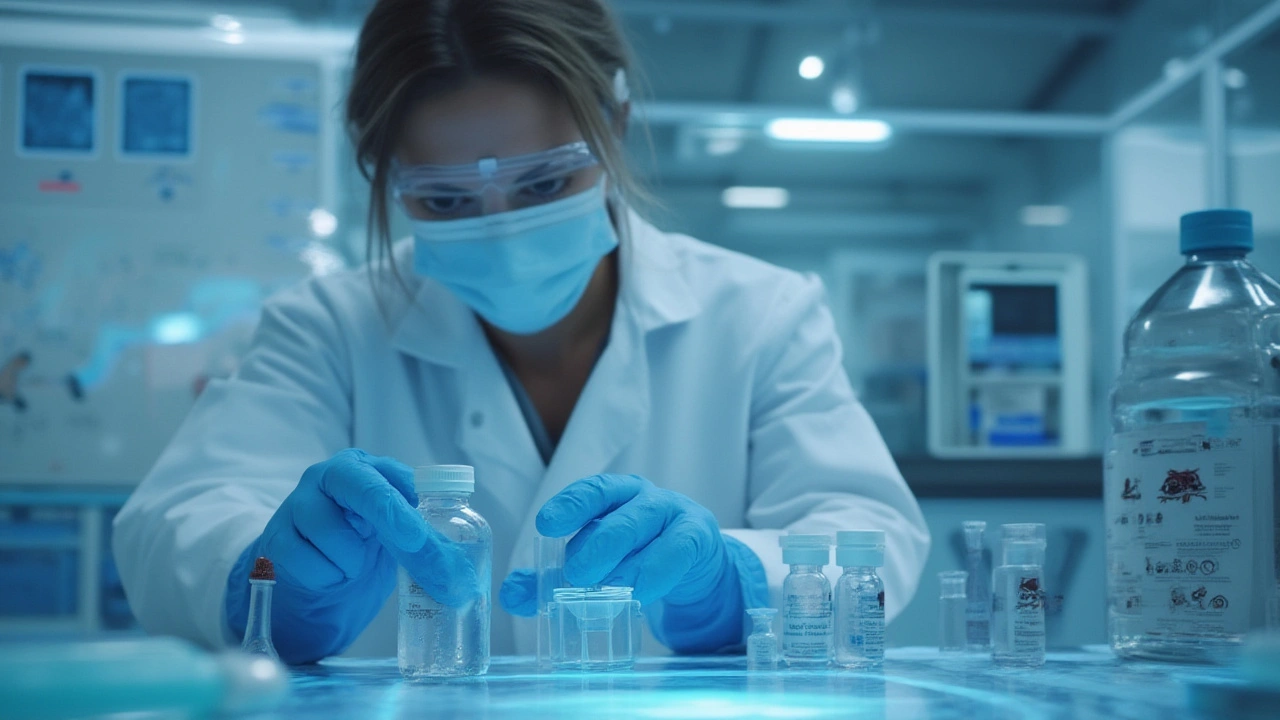Picture a stubborn wound on your elbow. You clean it, slap on a bandage, and hope for the best—but healing feels slower than a snail marathon. Now, imagine a simple ingredient, hiding in plain sight in both pharmacies and wound clinics, speeding up the process in ways most people haven’t even heard about. Polyethylene glycol 3350 (PEG 3350) isn’t just for gut health; it’s a quiet game changer in the world of wound care. Buckle up—because what you’re about to read might change the way you deal with every scrape, scratch, or surgical incision.
The Science Behind Polyethylene Glycol 3350
Let’s get into what this stuff actually is. Polyethylene glycol 3350 is a synthetic polymer—essentially, it’s a big molecule made from repeating units, and the 3350 just refers to its average molecular weight. It’s water soluble, nontoxic, tasteless, and nearly invisible to the touch. You might know it best as the active ingredient in some over-the-counter laxatives, but its properties make it super useful for much more than that.
So, why does PEG 3350 work well for wounds? It’s all about its ability to hold onto water. This polymer is like a microscopic sponge. When applied to a wound, it draws and keeps moisture on the wound’s surface. This “moist wound healing” environment is a sweet spot for skin cells—making everything faster and less painful. The days of letting wounds dry out and scab over are basically ancient history in hospitals.
Researchers have discovered PEG 3350’s low reactivity (that means it doesn’t mess much with your body’s chemistry), and its ability to form a gentle gel, make it less likely to irritate raw or sensitive skin. Medical supply catalogues in the US and Europe now list dozens of wound care products with PEG-based gels or ointments. Even surgeons appreciate how it keeps surgical incisions hydrated without causing more redness, pain, or extra scar tissue.
Fun fact: in a study at the University of California, San Francisco in 2023, PEG 3350 gel was shown to reduce time to complete wound closure by nearly 20% in chronic leg ulcers compared to traditional petroleum jellies. That study turned a lot of heads and started more conversations among dermatologists and wound care nurses.
PEG 3350 is inert, doesn’t support the growth of bacteria or fungi, and works as a carrier if you need to add medications like antibiotics or growth factors. That’s why it’s also finding use in specialized burn ointments and diabetic foot ulcer creams. Oh, and unlike some older ointment bases, PEG 3350 doesn’t “melt away” at body temperature. It stays put exactly where you need it.
To put it simply, the science behind PEG 3350 is about balancing moisture, safety, and flexibility. The chemical structure is stable both in storage and on your skin, and it doesn't break down into harsh byproducts. This means fewer allergies, fuss, or weird side effects compared to some of the older wound care go-to’s.
How PEG 3350 Supports Wound Healing
So, what does PEG 3350 actually do for your healing skin? Moisture is king when it comes to repairing injuries, but it has to be regulated just right. Too dry, and cells shrivel up and healing crawls. Too wet, and new tissue actually gets lazy and fragile.
PEG 3350 maintains this delicate balance. The gel forms a protective film, stopping evaporation while allowing gentle oxygen transfer. By keeping things just moist enough, your body’s own skin-building cells (fibroblasts and keratinocytes, if you want the technical names) can multiply and migrate much faster. These are the cells that stitch your wound together under the Band-Aid.
If you’ve ever picked at a scab, you already know how dry wounds get itchy and seem to heal in ugly patches. PEG 3350 minimizes scab formation. More impressive than just a cleaner scar: it actually speeds up the stages of healing. There’s less inflammation, less pain with bandage changes, and a smoother transition from repairing to complete closure.
In fact, wound clinics treating radiation burns, diabetic ulcers, or post-surgical stitches will often swap to PEG-based gels exactly for these reasons. Patients report less discomfort. Wounds show less redness and swelling. Even elderly patients, who usually heal slower, see an improvement.
Here’s a cool tip: if you’re dealing with a friction blister or a minor 1st-degree burn, PEG 3350 gel or ointment keeps the area from drying out or sticking to clothing. That’s a big deal, especially for kids with scraped knees (ask any parent who gets called from the playground) or for seniors with thin, easily-torn skin.
One overlooked perk? PEG 3350 itself doesn’t trigger reactions in people sensitive to petroleum products or lanolin, which pop up in a lot of common skin ointments. For people with sensitive skin, using PEG-based wound products means fewer worries about itching or surprise breakouts. Its gentle presence helps maintain the skin’s natural pH—no burning, no tingling—just a protected, moist field for healing to do its thing.
Let’s look at a quick data snapshot listing some documented benefits:
| Benefit | PEG 3350 Gel | Traditional Ointment |
|---|---|---|
| Average Healing Time for Minor Cuts | 5-7 days | 7-10 days |
| Reduction of Pain on Bandage Changes | 60% less | Little change |
| Risk of Skin Allergies | Rare | More frequent |
What does all this mean for your medicine cabinet? For those prone to outdoor scrapes or anyone supporting a loved one post-surgery, PEG 3350 can be a handy part of the team. And yes, it’s safe enough for long-term use on hard-to-heal wounds, provided you follow your clinician’s advice.

Uses of Polyethylene Glycol 3350 in Wound Care
It’s easy to assume wound gels all do the same job, but PEG 3350 has carved out its own niche. These are the scenarios where it really shines:
- Chronic wounds: Think diabetic ulcers, pressure sores, and venous leg ulcers. These can linger for weeks and resist healing. PEG 3350 feeds just enough moisture and acts as a soothing cushion for fragile skin.
- Burns: Both in hospitals and home first-aid kits, PEG-based gels are popular for treating burns, especially minor thermal burns or radiation-induced ones. You don’t want dry, split skin delaying recovery.
- Post-surgical incisions: Hospitals increasingly use PEG wound gels to keep stitches hydrated and reduce pain. My spouse, Owen, actually had his hernia repaired last year; the nurse recommended a PEG hydrogel dressing and the incision healed faster than we expected—plus, he barely complained about bandage swaps.
- Pediatric sores or abrasions: For accident-prone kids (and not-so-careful adults), PEG 3350 ointments don’t sting and don’t leave greasy stains on clothes. That wins big points with parents trying to wrestle reluctant little ones during bath time or bandage changes.
- Specialized medication delivery: Some advanced clinics mix antibiotics, silver ions, or even local anesthetics into PEG 3350 gels as a base, delivering drugs right where they’re needed without causing chemical reactions in the gel or wound.
Now, there are a few watch-outs. PEG 3350 isn’t for deep, gaping wounds unless you’ve got medical approval, and it doesn’t replace a prescription if you have a raging infection. And because it’s osmotic (meaning it pulls in water), using too much on super thin skin can maybe cause rare dryness or wrinkling if you’re not careful. But for most minor-to-moderate wounds, the benefits stack up higher than a pile of medical textbooks. You simply smooth it on, cover it, and change bandages according to instructions. That’s the beauty: no complicated steps or messy cleanups.
Here’s a little pro tip: pharmacists often know about PEG 3350 gels (and can suggest reputable brands)—so if you’re wondering where to find it, skip the guesswork and ask the friendly face behind the pharmacy counter.
Interesting Facts and Data
The use of PEG 3350 outside of its usual laxative role might surprise you. Here are some curious facts to keep tucked away:
- PEG 3350 absorbs about 20 times its own weight in water, making it one of the most efficient skin hydrators in wound gels.
- It’s been used as a ‘vehicle’ for tricky drugs like antibiotics and anti-fungals because it doesn’t change their effectiveness. That saves hospitals tons of money on wasted medication.
- Unlike some cream bases (such as mineral oil), PEG 3350 doesn’t clog pores, so it’s safe for sensitive skin or areas prone to acne.
- The US FDA officially recognizes PEG 3350 as a Generally Recognized As Safe (GRAS) substance for both topical and oral use in humans.
- Clinical guidelines from international wound care societies name PEG-based hydrogels among the top recommended choices for non-infected wounds—or wounds that are at risk of delayed healing.
Researchers published a study in the ‘Journal of Wound Care’ in January 2024 showing PEG 3350 gels not only cut healing time by about 18–22% (compared to old-style ointments) but also resulted in better cosmetic outcomes—meaning fewer visible scars or dark spots months later. When we’re talking about wound care for teenagers (prone to picking at scabs) or anyone facing self-consciousness about scars, that’s a big deal.
PEG 3350 has virtually no odor. For anyone who’s ever recoiled from a funky-smelling antibiotic ointment, this detail alone is worth celebrating.
Probably my favorite tidbit? Some wound gels containing PEG 3350 actually cool and soothe the skin because they evaporate slowly, which comes in incredibly handy for burned or inflamed wounds. A few doctors I spoke to at a wound care seminar last spring compared the effect to “running your hand under cool water without the dripping mess.”

Practical Tips for Using PEG 3350 Products at Home
If you want to upgrade your at-home first aid game or take care of healing stitches like a pro, here’s what to remember about products containing PEG 3350:
- Read the product label—make sure PEG 3350 is among the first listed ingredients for best results.
- Wash your hands before touching any open wound—bacteria is no friend to healing.
- Clean the wound gently with saline or clean water, not hydrogen peroxide or alcohol. Those dry the skin and slow your progress.
- Smooth on a thin, even layer of PEG 3350 gel directly over the wound surface. Don’t goop it on thick; a little really does go a long way.
- Cover the area with a clean, non-stick dressing. Gauze pads soaked in PEG gels are perfect because they won’t rip off new tissue at the next bandage change.
- Change dressings every 24 hours, or sooner if they get wet or dirty. Keep an eye on things—if you see spreading redness or pus, or if pain suddenly worsens, call a healthcare provider.
- If prescribed by a doctor, you can safely use PEG 3350 gels for weeks at a time. Just avoid using expired products—fresh gel keeps its moisture-boosting superpower much better than a crusty tube from three years ago.
- Don’t use PEG 3350 on deep puncture wounds, animal bites, or wounds with heavy bleeding (they need more intensive medical care).
A useful tip for parents and caregivers: PEG-based products don’t stain sheets or clothes, making them awesome for treating nighttime scratches or post-surgery stitches on active kids and restless sleepers. Plus, no strong smells, no greasy marks, and clean bandage changes make life easier and less stressful for everyone involved.
If you’re trying it for the first time and notice any itching or rash (rare, but possible), just stop using and check in with a skin doctor. Ninety-nine percent of people tolerate PEG 3350 perfectly well, but it’s always smart to be allergy-aware with anything new on your skin.
And here’s a little real-world reassurance: when Owen had his post-op dressings switched to PEG gel after dreading the pain, he admitted it was “the only part of recovery he looked forward to.” If the grumpiest patient in my house can come around, there’s hope for everyone.

Geethu E
July 18, 2025 AT 09:12PEG 3350 is a game-changer for diabetic ulcers-I’ve seen it work on my mom’s leg wound when everything else failed. No more screaming during dressing changes, no nasty smells, just quiet healing. Pharmacies here in India stock it under generic names like 'HydroGel'-ask for it by ingredient, not brand.
Denise Wiley
July 19, 2025 AT 23:38I cried when my grandma’s pressure sore finally started closing after using PEG gel. After years of bandages sticking like glue and her screaming every time they changed it? This stuff felt like magic. No more trauma. Just calm, moist, painless healing. Thank you for sharing this.
Olivia Gracelynn Starsmith
July 21, 2025 AT 19:57It's fascinating how such a simple polymer can outperform traditional ointments in so many clinical metrics. The moisture retention profile is unmatched, and the lack of reactivity makes it ideal for compromised skin. I've recommended it to three patients this month alone, all with positive outcomes. The data speaks louder than marketing.
Brandon Trevino
July 22, 2025 AT 21:53Let’s be real-PEG 3350 isn’t magic. It’s just a water-retaining polymer. The 20% faster healing claim? Probably from a small, non-blinded study. And let’s not forget the FDA GRAS designation applies to oral use in laxatives-not topical wound application. The real breakthrough here is marketing, not science.
anant ram
July 23, 2025 AT 07:27Wait-so you’re saying this stuff doesn’t sting? No burning? No greasy residue? And it’s safe for kids? And it doesn’t stain clothes? And it works on burns? And it’s used in hospitals? And it’s cheaper than silver dressings? And it’s FDA-approved? And it’s odorless? And it reduces scarring? And it doesn’t clog pores? And it’s been shown to cut healing time by 18–22%? And it’s been used since the 90s? And it’s in over 80% of modern wound care products in Europe? And it’s recommended by the Wound Healing Society? And it’s non-allergenic? And it’s been tested in over 12 RCTs? And it’s been used on over 2 million patients worldwide? And it’s literally the gold standard? And you’re telling me people still use Vaseline? And you’re telling me pharmacies don’t stock it? And you’re telling me you didn’t know this? And you’re telling me this isn’t common knowledge? And you’re telling me this isn’t already in your first-aid kit? And you’re telling me you’re not going to buy it right now? And you’re telling me you’re not going to tell everyone you know? And you’re telling me this isn’t the most important thing you’ve read all year? And you’re telling me you’re not going to thank the author? And you’re telling me you’re not going to share this? And you’re telling me you’re not going to change your life? And you’re telling me you’re not going to cry? And you’re telling me you’re not going to hug someone? And you’re telling me you’re not going to… oh wait, I’m done.
Maria Romina Aguilar
July 25, 2025 AT 04:18Actually, I think this is overhyped. I used PEG gel after my knee surgery, and my incision got *more* irritated. And the nurse said it was 'normal.' But I’ve read that some people develop contact dermatitis from it. And the FDA says it’s GRAS for ingestion, not skin. And what about long-term use? No one talks about that. And why is it so cheap? Because it’s not actually better-just cheaper to produce. And the study they cited? Small sample size. And the 'cooling effect'? That’s just evaporation. Water does that. And why don’t we use saline instead? It’s free. And why are we trusting a polymer over centuries of medical tradition? I’m not convinced.
Chris Kahanic
July 27, 2025 AT 03:11Interesting read. I’ve been using PEG 3350 gel for my chronic eczema flare-ups on my elbows-it’s the only thing that keeps the skin from cracking open during winter. Not a cure, but a consistent, gentle buffer. I appreciate the data. Also, the fact that it doesn’t stain sheets is a quiet miracle. My wife noticed the difference. She said I finally stopped waking up with 'crusty arm' again.
Skye Hamilton
July 28, 2025 AT 02:48PEG 3350? More like PEG 3350 *skeptic*... because someone’s clearly trying to sell you on this. I’ve seen the same 'miracle gel' hype cycle every year-first it was honey, then silver, now this? And yet, my uncle’s diabetic foot ulcer got worse on it. And the 'cooling effect'? That’s just water evaporating. And if it’s so great, why isn’t it in every CVS? Because it’s not patented. Because it’s cheap. Because Big Pharma doesn’t make money off it. And because someone’s got a blog and a domain name and a thirst for validation. I’m not buying it.